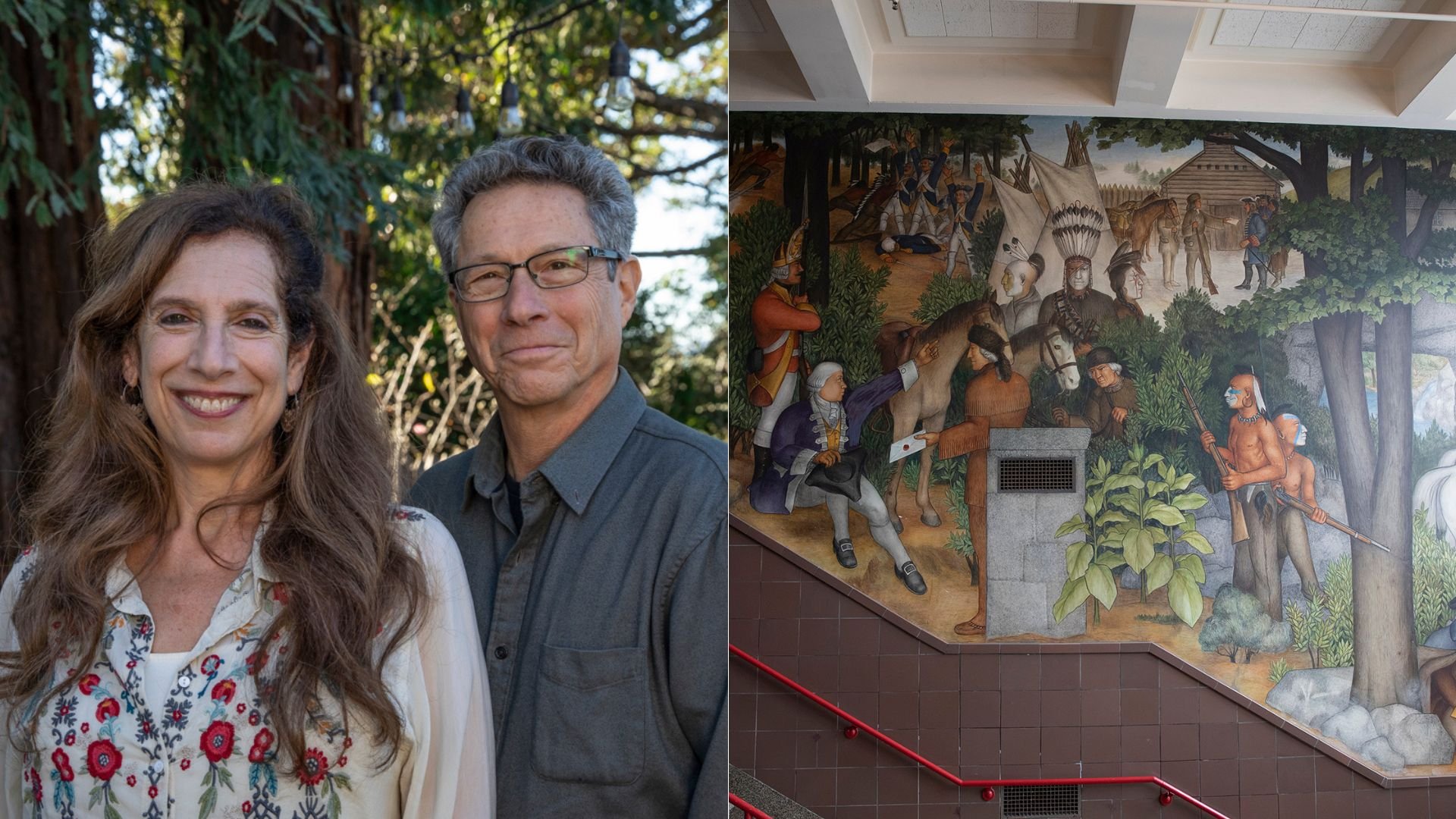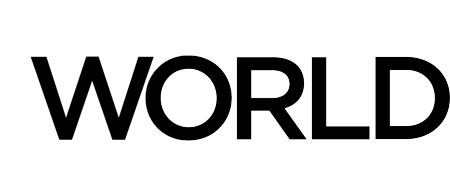"When you find how hard it is to understand why an image is so problematic, you realize how profound the erasure of people's historical traumas has been."

At the heart of Town Destroyer, a new America ReFramed film now streaming on WORLD during Native American Heritage Month, is an extensive piece of artwork that becomes the touchstone of heated controversy and passionate debate in one San Francisco community. While the 13 murals depicting the life of George Washington subverts historical perception of one of the most famous Founding Fathers, it has also become a triggering point with visuals of the injustices endured by Native Americans and African Americans.
Filmmakers Deborah Kaufman and Alan Snitow, who live in Berkeley, CA, just a stone’s throw from the high school where the murals are publicly displayed, sought to tell the story of the dispute in a way that presented more than one side and let viewers form their own opinions.
“Part of the exploration of the film is to understand these symbols, this work of art and how it impacts people in the past and of today,” Kaufman said. “Can we learn from this?”
It’s a question threaded through every scene of the documentary, which explores art as a political device, the persistent and lasting effects of generational trauma and the importance of owning and learning from our history as it delves into just one example of the tension between censorship and education.
WORLD: How does the title "Town Destroyer" play into the meaning of the film?
Deborah Kaufman: "Town Destroyer" is about a conflict over a New Deal-era mural in a public school in San Francisco; it is a depiction of the life of George Washington that includes images of his plantation, where he owned slaves, and of Native Americans, one of whom is murdered by settlers. This mural became very controversial a few years ago because the depictions were triggering emotional responses and difficulty amongst the students and parents in the community.
The conflict that developed is the subject of our film and the inquiry we have into how we look at art and American history. What do the depictions mean at a time of racial reckoning, and of very disparate points of view, throughout the country?
Alan Snitow: The name "Town Destroyer" comes from this idea about George Washington, who was called by the Seneca and other Shawnee, "Hanodaga:yas," which means "town destroyer," after Washington ordered the destruction of Shawnee villages and crops during the Revolutionary War.
DK: "Town Destroyer" has a bit of a double meaning, because not only is it the name that the Seneca Mohawk called George Washington, but the town destroyer is the mural itself, Life of Washington, because it destroyed a sense of unity and purpose amongst people in San Francisco.
W: What inspired you to want to tell this story?
DK: We saw the murals in 2019, right at the time that we were hearing about the conflict and the Board of Education was having open hearings about the fate of the murals. [And] so we went into the school to see this monumental work of 13 panels on the wall of George Washington's life and times.
We knew the artist Victor Arnautoff – he's very famous in San Francisco for doing Coit Tower and a number of other mural monuments – but we hadn't seen this, and were stunned by the comprehensiveness and the fact that, at the time, these murals must have been something pretty radical. They showed who the true George Washington was. In the 1930s, no one was learning that Washington was a slave owner. No one was learning about the true history of Native Americans. It’s very apparent when you walk in that these are older murals, but they're telling a new story about our Founding Fathers.
AS: We read about the controversy over the fate of these murals in the newspapers and thought that it was a fascinating story because it involved a major work of art in San Francisco history and one of the most, if not the most, important figures in American history. It also involved the most controversial issue in the United States: the history of slavery. George Washington was a major slave owner at the time of the revolution, and also the seizure of Native lands, because he was considered the most important land speculator in Native land in the West. So, you have a whole different frame of reference of looking at George Washington.
W: How did you decide to frame the debate?
AS: As we heard the arguments, we were torn, so we decided that was something we wanted to produce in the film for the audience, for people to start seeing things in a more complex way and that tears apart the singularity of how they look at issues.
A long-term part of Native ceremony has been the idea of breaking the binary as a way of reconciliation. Breaking the binary means getting out of the “either-or” [or] “one group or another” concept of what an issue is about to be able to see a multiplicity of sides, to hear the various voices and to provide real credibility and respect to those different points of view.
Breaking the binary doesn't mean that you get along with everybody. What it means is that if you're going to build political movements and solidarity, then you're going to have to deal with differences and problems. You're going to have to deal with history, and that's always going to be hard. As [artist] Dewey Crumpler says in the film, “The purpose of art is to be difficult, because out of that difficulty comes the possibility of change.”
DK: It was important for us to have a real chorus – a multiplicity of voices – because we felt that many people's opinions needed to be validated and were true. It gave us an opportunity to spend time talking with people in the arts community, historians, Native Americans, African Americans and others who were impacted by this work of art and had a lot to say about it.
We hadn’t come in wanting to make an advocacy film; we wanted to go beyond that paradigm of “winner take all” and portray that what was important was listening. What's missing in American society today is the ability to listen to points of view that are difficult to take in.
AS: We also wanted to raise the question of, “How do you look at art? What is the power of art?” Very often in American society, art is thought of as not particularly important, politically. And then you see the controversies that erupt around works of art. These are images in which the power is left up to the viewer to absorb and try to interpret, and we wanted to be able to give some guidance about how to do that in this film.
The power of murals and muralism is extraordinary. If you walk through San Francisco, there are entire streets that are covered with paintings representing different communities and issues. The idea of art being a powerful statement of identity, politics, the future and of how people think about themselves and their communities is very important and impressive to us.
W: How did you convey the tension between trauma, censorship and historical memory that we witness in the film?
DK: These murals were being fought over the question of, “Is this a teaching opportunity?” As time went by, politics and events took place in other states like Texas, Florida and Tennessee, where books were being banned, and students were starting to say, “Wait a minute, we want to read about this history. We want to know about these things. Maybe we have to figure out a way to contextualize these murals so that we learn from them. Don't take them down, because they're showing, yes, the ugly side of American history, but that is part of our history, and we have to learn how to deal with it.”
What we were hearing was that the murals were triggering, that historical trauma was being passed on to a younger generation. As we learned more and more, it was not just the kids, but the parents who made it the national issue that it became. It's very important to listen to kids now. Younger people are growing up in an environment that's really different from what we grew up with, and when they say they feel vulnerable, adults need to listen.
It’s walking this tightrope between understanding and paying attention to vulnerability and at the same time being free to talk about difficult issues in our history and to look at things that are very challenging.
AS: Especially right now, when we're seeing this wildly expanding drive in places all across the country toward censoring anything about the LGBTQ+ community, critical race studies and on and on. This is a moment when censorship has become a regular phenomenon, and we wanted to address that.
How do you take on this question without covering up the realities that existed? Native people didn't want their kids walking by a full-size, eye-level corpse in the middle of the school. That was a very complicated and traumatic experience that people were going through. History is very cruel to a lot of people. How do we address that without recapitulating the traumas that communities have gone through? It's a key question that we have to address, and we can't do it in the way that the right wing, for example, is trying to do, by obliterating entire areas of knowledge. That kind of obliteration of content is a prelude to a different kind of trauma – of a repression of ideas, thoughts and people who do not fit into a reigning idea of what we should be talking about.
W: How did your personal perspective lend itself to the making of this film?
AS: We tried to put [the debate] within our own frame of reference, which has to do with being Jewish. We thought, what if our kids were going into a school and passing by a historically accurate representation of a pile of bodies at Buchenwald? Would we want that to be something that they looked at every day?
This kind of issue is something that needs to be addressed more. Sometimes the difficulty is what makes it worthwhile; the harder it gets, the more something attracts us, because we want to find out how we stand in this.
DK: It’s very controversial dealing with these things, but we wanted to listen, and I think people appreciated that two outsiders wanted to listen to people tell their stories. And we're still listening.
What was our stake in this as two older white people dealing with the underrepresented voices of people talking about slaves and the legacy of history for Native Americans? We didn't come in with a script that had a finale advocating a particular point of view; it was going to be open-ended. It was a challenge to really keep an open mind every step of the way, and that's the challenge of filmmaking. A good documentary is going to open your minds – it's a process of discovery and learning all the way through.
Town Destroyer is now streaming online and on the PBS app.
Discuss and engage with us on Facebook, Instagram, Twitter and TikTok by using the hashtag #TownDestroyer and tagging us @worldchannel. Subscribe to our newsletter and YouTube for more features including events and interviews.
Enjoy our content? Consider donating to keep important storytelling like this going, and find more on PBS Passport.



